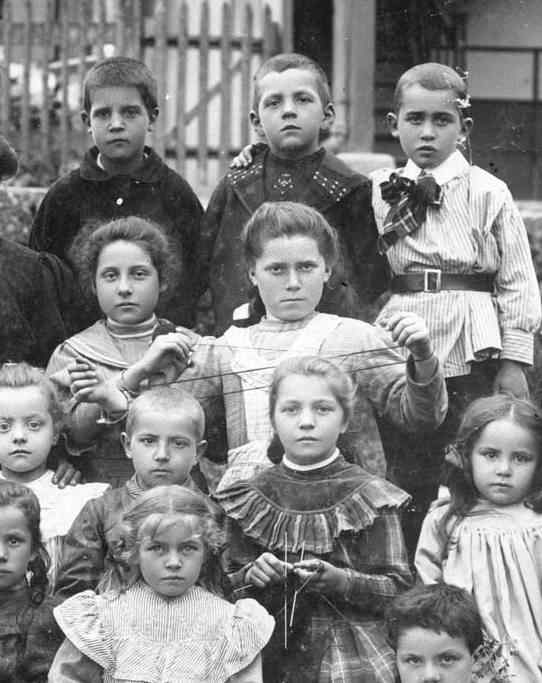
Figure 1.--Here we see children at the primary school at Vingelz in 1908. The Vingelz photographs show all kinds of interesting activities and items at the school. Note here two good friends, girls playing a string game, and other girls knitting.

Here we have wonderful photographs from the primary school of Vingelz. This was a village 30 km north of Bern. We do not know much more about the village. Normally these village schools did not have names, but rather just known as village school. Thus the Vingelz school would have known as the village or Vingelz school. It was a small wood-frame school in a rural area. This was a German speaking area and the school would have been taught in German. The wonderful images available give us wonderful insights into both school life and how the children dressed over several years. The photographs are especially interesting because the children are not just posing stiffly, but displaing all kinds of interwting items and activities.
This was a village 30 kilometers (km) north of Bern. We do not know much more about the village. The children in the 1908 photograph look to be quite prosperous. All have shoes. The children in the 1917 photograph look much less prosperous. Most were barefoot. We are not sure why the images are so different. Of course World War I was in progress. Switzerland was neutral in the War. But the economy was undoubtedly affected by the War.
Here we have wonderful photographs from the primary school of Vingelz. Normally these village schools did not have names, but rather just known as village school. Thus the Vingelz school would have known as the village or Vingelz school. It was a small wood-frame school in a rural area. This was a German speaking area and the school would have been taught in German. The wonderful images available give us wonderful insights into both school life and how the children dressed over several years. The photographs are especially interesting because the children are not just posing stiffly, but displaing all kinds of interesing items and activities. The school had a young lady teacher in 1908. We do not see the teacher is 1917.
Here we see the children and their young lady teacher in 1908. Notice how the teacher is sitting in the middle of the class. This seems to suggest a closer relationship with the children than similar portraits where the teacher is at the side or behind the class. The children all look quite young. We wonder if there could have been a class with the older children. The Vingelz photographs show all kinds of interesting activities and items at the school. Not all of the children are diszplaying items, but many are. Note here two good friends, girls playing a string game, and other girls knitting. One particularly interesting item is the class abacus. At the time I believe that the abacus was widely used to teach mathematics. Notice how one boy is showing it off. Other children are showing off their books. We see all kinds of outfits. The girls wear dresses, some with pinafores. Tghe boys wear smocks, tunics and a variety of shirts and jackets. Two boys have large floppy bows.
Here we see the children at the same school in 1917. The teacher is not included in this portrait. Again we see mostly younger children. We do not know if there was a class of older children. Again the Vingelz photographs show all kinds of interesting activities and items at the school. There is quite a bit going on here. The children seem to have brought out potted pants to include in the photograoh. Many girls hold either flowers or baskets. I'm not sure what the baskets are for. Two girls show off their slate and book. Two children hold what looks to be their pencil boxes. One boy has his book satchel. One of the boys in front has something on his shoulder, but we can't make it out. Several of the children wear smocks or smock pinafores, including the boys. This was more common than we see in the 1908 Photograph. I'm not sure just when this became mandatory. One noticeable observation is that the children do not seen nearly as well dressed as in the 1908 photograph, We are guessing that World War I was a factor. Switzerland was neutral, but all the surrounding countries were involved.
The school has an interesting site. The site has many photos showing the school over time.
Related Chronolgy Pages in the Boys' Historical Web Site
[Main Chronology Page]
[The 1880s]
[The 1930s]
[The 1940s]
[The 1950s]
[The 1960s]
[The 1970s]
[The 1980s]
Related Style Pages in the Boys' Historical Web Site
[Return to the Main individual Swiss school page]
[Main Swiss smock page]
[Main country page]
[Long pants suits]
[Short pants suits]
[Socks]
[Eton suits]
[Jacket and trousers]
[Blazer
[School sandals]
Navigate the Boys' Historical Clothing School Uniform Pages
[Main School Uniform Page]
[Australia]
[England]
[France]
[Germany]
[Italy]
[Japan]
[New Zealand]
[Scotland]
[United States]
Navigate the Boys' Historical Clothing Web Page
[Introduction]
[Activities]
[Biographies]
[Chronology]
[Clothing styles]
[Countries]
[Bibliographies]
[Contributions]
[FAQs]
[Glossary]
[Satellite sites]
[Tools]
[Boys' Clothing Home]
